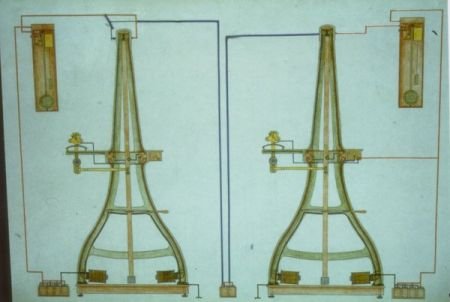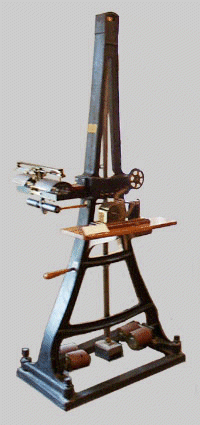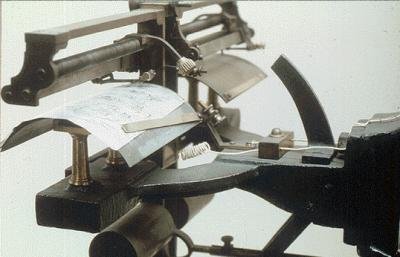|
Caselli´s pantélégraphe

Caselli´s pantélégraphe makes it possible to transmit the autograph, so that its writing can be recognized at the station of arrival... The dispatch is written with a fatty ink, on a tin sheet, this sheet is then placed on a metal F table, having a cylindrical curve.
Figure 1
Extracted the book " Treated of elementary Physics " of HC Figure 1 On this table is driven a small metal point P, which carries out the same movements as if one wanted to stripe the tin sheet transversely, on all its surface. These movements are obtained, on the one hand by means of a pendulum OM, connected to the point as indicates it figure 2, so that the end of the pendulum describing the arc MN, the point describes, perpendicular to the axis of the metal table, arc PQ, in addition, by means of a screw pitch, which is indicated out of U in figure 1, and which advances the point of a small quantity, in the direction of the axis of the table, between two consecutive oscillations of the pendulum. - The metal rod which carries the point P communicates, in K, with positive pole A of a pile and with line LL, the table E communicates with the negative pole B of the pile and with the ground T.
Figure 2
Extracted Treated book the " of elementary Physics " of Figure 2 From there results that, as long as the point P supports on the parts of the tin sheet which are not covered with ink, the current passes, almost entirely, in the circuit AKPEB, which offers a resistance much less considerable to him than the wire of the line.
Figure 3
On the contrary, when the point P comes to touch the parts of the sheet from tin which are not covered with fatty ink, the current cannot pass more from the point to the table E, it passes then on the wire of the line LL, which brings it to another apparatus, located at the station of arrival, and similar to that of the starting station. - The wire of line ends in the same way, in this apparatus, with the axis K which carries the iron P point, and the table E receives a paper sheet, moistened of potassium a yellow cyanide solution, all the times that the power is on from the iron P point in the table E to go to the ground Y, it break up yellow cyanide, and leave a trace of Prussian blue, from which the length is equal to the arc traversed by the point during the passage of the current. The point advances besides in the parallel direction of the table, with each oscillation of the pendulum, as in the apparatus of the starting station.
Figure 4
One thus sees that if the movement of the two pendulums are rigorously synchronous, the data receiver will provide a series of small parallel features, whose whole will produce, ultimately, the exact aspect of the characters traced with ink by the shipper. Figures 3 and 4 show how one can reproduce, not only characters of writing, but an unspecified drawing, rectilinear features, etc. Figure 3 is a specimen of the dispatch, such as it is delivered by the sender; figure 4 is the dispatch reproduced by the apparatus of the station of arrival. It is by the reproduction of a rectilinear feature, traced in parallel at the edge of the sheet, like one of the vertical features of figure 3, which one regulates the synchronism of the two apparatuses. - It is clear that, if this synchronism is not rigorously established, the apparatus of arrival would give only one illegible dispatch.
Caselli's  Pantelegraph Pantelegraph
Both Christophe in his The Fenouillard Family, written in 1893, and Jules Verne in his recently discovered manuscript Paris in the 20th Century, dating from 1863, mention a process enabling the long-distance transmission of drawings, ideograms or facsimiles: the Caselli pantelegraph.
Its inventor, Giovanni Caselli, born in Siena in 1815, was the incumbent of an ecclesiastical living. While teaching physics at the University of Florence, he devoted his research to making progress in the telegraphic transmission of images, an issue which had been proving a stumbling block for several researchers for quite a few years, including the Britons Bain and Bakewell, due to a failure to achieve a perfect synchronization between transmitting and receiving devices.
In 1856, the results were conclusive enough for the Grand Duke of Tuscany to take an interest in Caselli's invention and, the following year, Caselli went to Paris where he was to be given decisive help by the famous inventor and mechanical engineer Paul Gustave Froment, to whom he had been recommended by Foucault, who had already entrusted Caselli with the task of making his pendulum. Once completed, the final device met with unequivocal enthusiasm from the Parisian scientific world and a Pantelegraph Society was created to prepare its exploitation.

What is more, the Emperor Napoleon III himself, passionately interested in mechanics and modern inventions, visited Froment's workshops on May 10th 1860 to watch a demonstration of the device. The enthusiastic Emperor gave Caselli access to the lines he needed in order to continue his experiments in Paris, from the Froment workshops to the Observatory. Then, in November of the same year, a telegraphic line was also allocated to Caselli between Paris and Amiens to enable a real inter-city experiment, which was apparently a total success. Caselli had in fact managed to eliminate the last remaining fault in his machine by making the synchronization timers independent of the current relayed by the telegraphic line itself, which was too sensitive to atmospheric disturbances. The French press was brimming with laudatory articles on the pantelegraph, while the top brass from high society and the scientific and administrative worlds hurried along to Froment's workshops to find out about the new process. In September 1861, King Victor-Emmanuel invited Caselli and his machines to a series of triumphant demonstrations at the Florence Exhibition.
Finally, in 1863, the French Legislature and Council of State adopted texts authorizing the official exploitation of an initial line between Paris and Marseille, while across the Channel, Caselli obtained authorization for the experimental use of a line between London and Liverpool over a four-month period.
However, the Pantelegraph Society did not prove equal to the market which was apparently opening up and, failing to undertake any energetic promotion of the device, was content to wait passively for its capital to be remunerated via the flood of orders which were supposed to pour in from all over the world.
In Italy, after an initially euphoric reception, the sluggishness of the administration and haughtiness of ministers led Caselli to give up any further development of his invention. In France, he clashed with the Telegraphs administration which, fearing competition with its ordinary telegraphic network, refused to lower the tariff for handwritten dispatches -which were nevertheless prohibitive - and even advised taxing such dispatches at a higher rate than ordinary ones.
When the pantelegraph appeared, France was in fact in the process of setting up a complete telegraphic network, using the Hugues, Morse and then Baudot systems, replacing the former Chappe optical telegraph, which had been experimented since 1792. More than just a technical step forward, a qualitative transformation in the use of the telegraph system was underway. What had until then been an instrument of the governing powers and the stock exchange, was about to establish itself as a relatively commonplace means of communication, conveying a variety of urgent yet trivial pieces of news such as births, deaths, marriages or tourist hotel reservations. Because it had previously been limited to two powerful forces requiring extreme rapidity and perfect secrecy - the State and Finance - the Chappe telegraph had quickly become a myth within French society.
What is more, popular literature glorified the telegraph's somewhat worrying and imperial vocation in this respect as, for example, in Alexander Dumas' The Count of Monte Cristo, or in the chronicles of the would-be-poet Barthélemy. The myth of instantantaneousness at the exclusive service of the government or the banking sector was about to become outdated at the very time when Caselli thought he was reaching his goal. Designed to transmit images, the pantelegraph, like today's fax, was perfectly able to transmit written texts correctly. However, whether conscious or not, there was a general refusal to allow it any other other role than the transmission of a banking signature or a trademark, since this was the only system capable of doing so, and the administration went on to ensure it was gently stifled out of existence.
Any innovation strategy contains a great many traps, not the least of which is indeed to become fascinated to the extent of being hemmed in by the new technology contained within a given invention and which distinguishes it from all other existing processes, to the ultimate detriment of its flexibility of use and any real possibilities of development.
In this respect, the pantelegraph adventure was all the more remarkable given that a tremendous short-cut was almost taken in the history of telecommunications at the time when its destiny was at stake in Paris. Indeed, in 1863, two top civil servants from the Chinese Empire requested a demonstration at the Froment workshops and could not hide their amazement and admiration in the face of an invention which, in one swoop, solved the tricky problem of the telegraphic transmission of ideograms. In 1884, fairly far-reaching negotiations appear to have taken place between China and Italy with the aim of carrying out experiments on the Caselli pantelegraph in Peking, but these were not followed up. However, this particular use of the telegraph, anticipated very early on by Caselli, was taken up much later by the Japanese, to whom we owe the massive diffusion of the fax.
Today, pantelegraphs lie dormant in a few rare museums. Those kept at the Musée National des Techniques were given another chance to prove their reliability in 1961, between Paris and Marseille, during the commemoration of the first tests, and in 1982, at the Postal Museum in Riquewihr, where they operated faultlessly, six hours a day, for several months.
|

